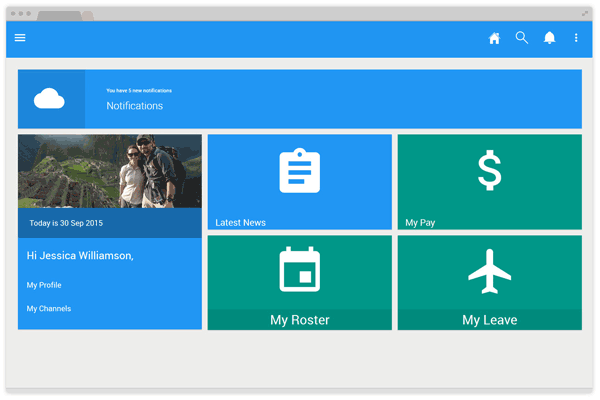Mumba Cloud gets down to business with Enterprise Social Hub

The Happy Accident, which is often cited as a principal ROI of enterprise social networks, refers to the chance discovery of the right person or the right piece of enterprise knowledge to solve a business or process challenge. For instance, Bruce in Melbourne, dealing with a corporate crisis, fires off an anxious Yammer/Jive/Tibbr post at 6.00pm in the evening Sydney time, before heading off to a nervous sleep. Meanwhile, as Bruce slumbers fitfully, at 3.00am the following morning Colleen logs in from Dublin and comes across the post and immediately fires back with the critical data. Bruce did not know Colleen was the one to turn to, nor even how to find here, it was all a Happy Accident. Enterprise Social wins again!
Anthony Zets, CEO and founder of Australian software start-up Mumba Cloud, thinks that the long odds of a Happy Accident occurring is a key reason why enterprise social tools such as Yammer and Jive are quickly adopted but fail to gain long term viability within the organization. He says that enterprise social software has moved past basic activity streams and now has the ability to overhaul business process and enhance day-to-day productivity.
The former Deloitte Analyst founded Mumba Corp in his parent’s garage in 2006, launching what he describes as an Enterprise Social Collaboration Hub. Relaunched in 2010 as Mumba Cloud, it aims to help in communicating and co-ordinating large, highly dispersed teams in global corporations. Its flagship customers include food service company Compass Group and facilities management group ISS World.
“Yammer approaches the market from the bottom up, and it’s all about unstructured, flat communication. It’s just meant to grow with absolutely zero structure within the organisation,” said Zets.
“Mumba Cloud from day one has always been a top down product where we focus on structure.
“It’s not just about providing communication and collaboration, its how do you scale that within a very large organisation where you’ve got thousands of employees. A product like Yammer works very well with 20, 50, 100 people, but thousands of people using Yammer and it just becomes a mess, just a stream of consciousness that’s impossible to follow. So we were looking at more practical solutions, how we actually deliver tangible value.”
Following a recent $A2 million capital raising, Mumba Cloud has added to its 12-strong Surry Hills, Sydney-based team with its two latest recruits, former eBay software engineer and legendary Joomla open source founder Andrew Eddie and enterprise software sales specialist Jeff Leibovici hired from Lexmark/ReadSoft. It is now on the hunt for more enterprise clients in Australia and planning a future move to the US.

Payroll and HR functions are embedded in the Mumba Cloud interface.
In addition to offering the typical elements of an enterprise social networking interface, Mumba Cloud includes useful applications to help avoid rogue IT implementations that pose security threats and potential loss of IP..
“We’ve got a survey tool and a knowledge base and a rich media module, and Wikis and pages, all that you would expect to find in various consumer social apps,” said Zets.
“But the way they can be manipulated and configured in Mumba Cloud supports business outcomes. We’ve got a lot of automation. We’ve developed a rules engine that allows you to automate these processes and map them. That’s what’s different.”
Further to the social applications, a program is underway to embed the essential functionality of enterprise apps such as Kronos and Chris21 into the Mumba Cloud interface. Mumba Cloud is actually building the front-end look and feel to these systems so that employees can access their payroll and rosters alongside business news and content all through the single Mumba Cloud application.
“We’re not looking to rebuild the entire interface, just the screens and the interfaces that are hitting your front line employees. For example what they need to fill in a leave application, we’re not building the whole back end administration.”
“As more software vendors move to the cloud and open their APIs, the more opportunity there is for vendors such as Mumba Cloud to come in and fill the gaps.”

CEO Anthony Zets prefers to refer to Mumba Cloud as a “hub” rather than the traditional portal. “A hub’s more of a destination, whereas you go through a portal, and a hub you can stick around at. So we’re looking to provide this hub that integrates these systems and that provides you this similar look and feel so that we can demonstrate tangible ROIs to these businesses.
When asked about document management, Zets has a plan for Mumba Cloud that is focused on integrating existing document management systems into their collaboration modules.
“Documents are a lot more meaningful when they’re in context, and while everybody has their file repositories where you’ve just got your documents listed, there’s no context provided. In Mumba Cloud, especially in the next version of our software that’s coming out, there’s going to be a lot of tools to be able to embed files in workflows, projects and in discussions and conversations, so that if you’re looking at a file you can easily understand why the file exists and what it is related to.
“It’s true that many organisations today look at SharePoint as the default for this, and theoretically you can do anything in SharePoint, but to actually get it to do what you really want would cost you a small fortune, and a lot of time and effort. It’s a very rapid implementation with Mumba Cloud, and it’s a significantly cheaper implementation.
